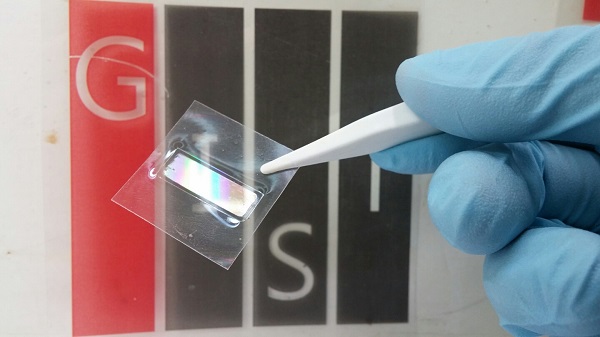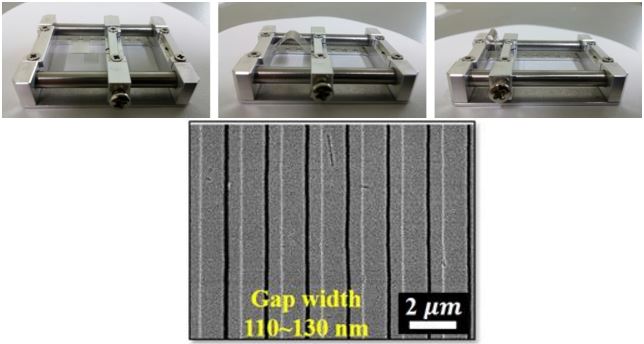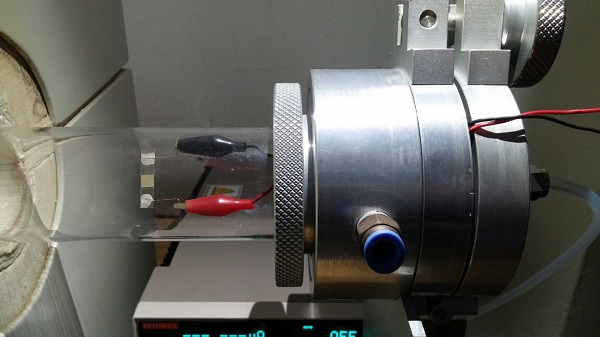Media Center
A multimedia mosaic of moments at GIST
GIST Excellence
[Press Release] GIST Research team led by Professor Gun-Young Jung has developed an ultra-sensitive hydrogen sensor
- 엘리스 리
- REG_DATE : 2015.10.21
- HIT : 786
Ultra-sensitive hydrogen sensor developed
that may one day be used on smartphones
Palladium nanoribbon array with a gap of less than 40 nm was created on a polyethylene terephthalate (PET) substrate - research published in Advanced Materials

(Figure 1) This image shows the actual palladium nanoribbon array
printed onto a plastic material after the metal transfer process.
A hydrogen-based economy would be environmentally friendly; however, the widespread use of hydrogen gas (H2) as an energy source can be very dangerous because of the inherent risk of explosions when the concentration of the gas is greater than 4%. To counteract this risk, Korean researchers led by GIST Professor Gun-Young Jung have developed a low-cost, ultra-sensitive sensor that can quickly measure hydrogen concentrations in the air. When used in conjunction with a growing hydrogen-based economy, this versatile sensor can be mounted on mobile devices (such as a smartphone) or even worn as a wearable sensor (such as on a lab coat), and potential applications for the sensor includes monitoring hydrogen fuel-cells in cars and in space exploration.
GIST Professor Gun-Young Jung (47 years old) and Ph.D. candidate Yusin Pak (32 years old, first-author) were supported in their research by the Pioneer Research Center Program and by Basic Science Research Program through the National Research Foundation of Korea (NRF) funded by the Ministry of Education. Their paper entitled "Palladium nanoribbon array for fast hydrogen gas sensing with ultrahigh sensitivity" was published by the prestigious online journal Advanced Materials on October 6, 2015.
The main content of the paper is organized as follows:
1. Research Motivation
Hydrogen sensors are difficult to commercialize because of the high manufacturing costs associated with the complexity of the designs. Moreover, previous sensors had difficulty in detecting hydrogen gas at room temperature and required high working temperatures to function properly, which also then increased the sensor"s power consumption and weight. These were some of the fundamental limitations in trying to create a ubiquitous hydrogen sensor that was small enough for practical commercial applications.
Researchers then became interested in using palladium (Pd) because it can selectively absorb hydrogen gas at room temperature, but Pd-based film sensors exhibited poor performance characteristics due to a small diffusion coefficient.
2. Research Results
The research team led by GIST Professor Gun-Young Jung have developed a low-cost, ultra-sensitive palladium nanoribbon (Pd-NRB) array sensor that can quickly measure hydrogen concentrations in the air at room temperature with outstanding performance characteristics that have not been seen in previous studies.

(Figure 2) Bending treatment of the Pd-NRB array sensor on a PET substrate showing pristine gaps without any bending, increased gap width by negative bending, and reduced gap width by positive bending. A SEM image shows the widened nanogap (110–130 nm) in the region of bending center after releasing bending strain.

(Figure 3) The Pd-NRB sensor array in an actual test to detect hydrogen gas. Electrodes are attached to both ends of the sensor, and a constant voltage is applied to the sensor so that any changes to the concentration of hydrogen gas inside the quartz tube can be measured.
The Pd-NRB sensor array represents a significant development for hydrogen sensors that are thousands of times more sensitive than non-palladium based sensors while improving the sensor"s performance for repeated use and improving the longevity of the sensor"s lifespan.

Professor Gun-Young Jung said, "This research demonstrates the feasibility of easily and precisely combining palladium with next-generation materials to create hydrogen sensors that utilizes the on-off characteristic of the nano-gap, which would allow for hydrogen sensors to be miniaturized with ultra-sensitivity and low power consumption, making them ideal sensors to be mounted on mobile devices such as smartphones."